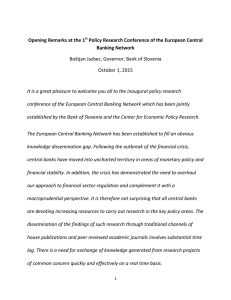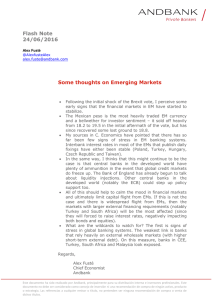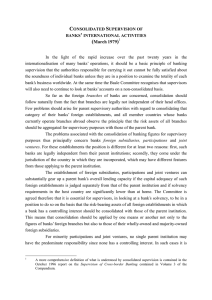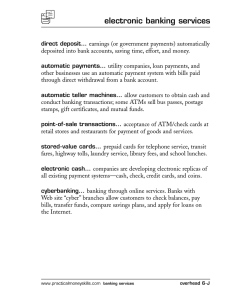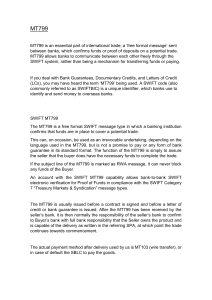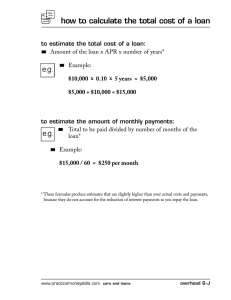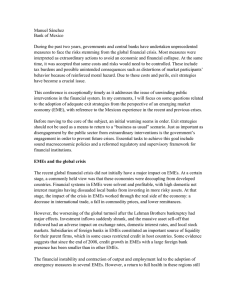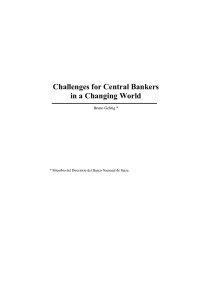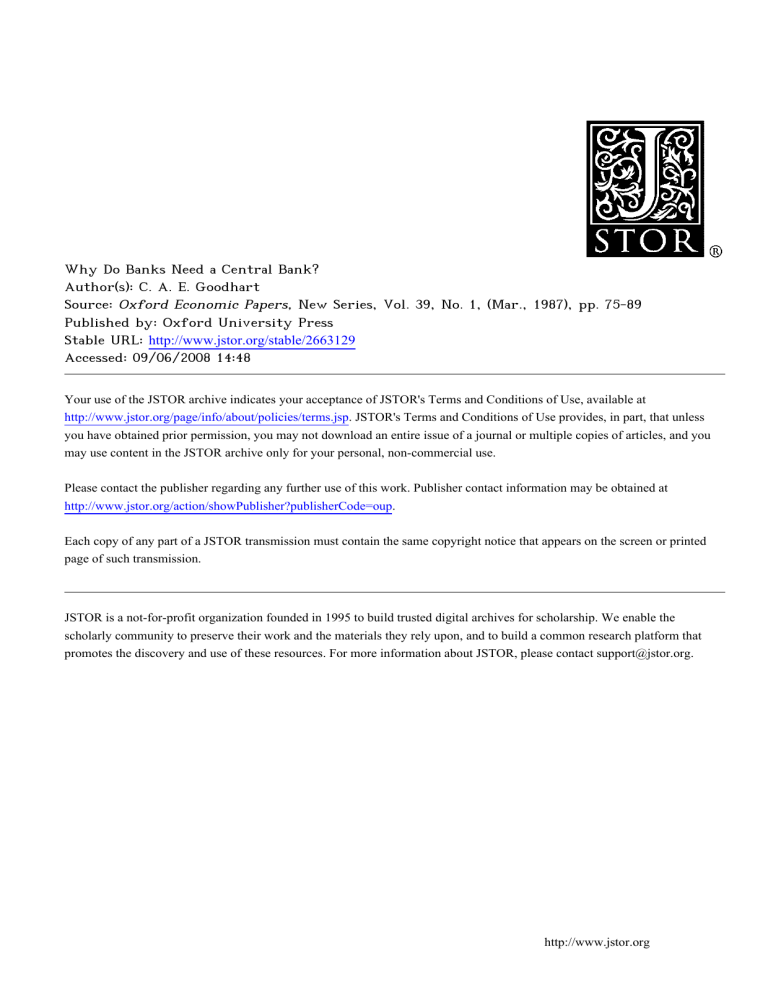
Why Do Banks Need a Central Bank? Author(s): C. A. E. Goodhart Source: Oxford Economic Papers, New Series, Vol. 39, No. 1, (Mar., 1987), pp. 75-89 Published by: Oxford University Press Stable URL: http://www.jstor.org/stable/2663129 Accessed: 09/06/2008 14:48 Your use of the JSTOR archive indicates your acceptance of JSTOR's Terms and Conditions of Use, available at http://www.jstor.org/page/info/about/policies/terms.jsp. JSTOR's Terms and Conditions of Use provides, in part, that unless you have obtained prior permission, you may not download an entire issue of a journal or multiple copies of articles, and you may use content in the JSTOR archive only for your personal, non-commercial use. Please contact the publisher regarding any further use of this work. Publisher contact information may be obtained at http://www.jstor.org/action/showPublisher?publisherCode=oup. Each copy of any part of a JSTOR transmission must contain the same copyright notice that appears on the screen or printed page of such transmission. JSTOR is a not-for-profit organization founded in 1995 to build trusted digital archives for scholarship. We enable the scholarly community to preserve their work and the materials they rely upon, and to build a common research platform that promotes the discovery and use of these resources. For more information about JSTOR, please contact support@jstor.org. http://www.jstor.org OxfordEconomicPapers39 (1987), 75-89 WHY DO BANKS NEED CENTRAL BANK?* A By C. A. E. GOODHART 1. Introduction The Evolution of Central Banks, (1985), especially Chapter 3, pages 28-35, I sought to examine the key features that distinguished banks from other financial intermediaries, and, in particular, necessitated the support of a Central Bank. This paper continues and extends that work. Fama, in his paper on 'Banking in the Theory of Finance', Journal of Monetary Economics, (1980), describes banks as having two functions, the first being to provide transactions and accounting services, the second being portfolio management. Yet transactions services are carried out by other institutions, e.g. giro, Post Office, non-bank credit card companies, etc., without much need for special supervision, etc, by a Central Bank.1 More important, I shall argue that it would be perfectly possible, generally safer, and a likely development, for transactions services to be provided by an altogether different set of financial intermediaries, i.e. intermediaries providing mutual collective investment in (primarily) marketable securities. If this was to occur, would it make such mutual investment intermediaries, e.g. unit trusts, open-end investment trusts, into banks? Would such intermediaries then become subject to the same risks as banks, and need to be subject to the same kind of supervision/regulation? I shall argue, in Section 2, that there is no necessary reason why banks alone among financial intermediaries should provide transactions services, and in their role as portfolio managers, banks have much in common with other intermediaries acting in this capacity (though, as I shall argue later, in Section 3, certain crucial distinctions remain between the characteristic form of portfolios held by banks as compared with those held by non-bank financial intermediaries). Nevertheless, it is this joint role that is held to give a special character to banking, and to require special treatment for banks through the establishment of a Central Bank, e.g. to provide Lender of Last Resort (LOLR) and other support services for banks in difficulties, support which goes beyond the assistance envisaged for other financial intermediaries that get into trouble. IN my earlier monograph, * This paper was originallypreparedfor the ManhattanInstituteConferencein New York, March 1986, and was also presented at seminars at NottinghamUniversity and Brasenose College, Oxford.I have benefittedgreatlyfromcommentsmade on those occasions,notablyby MaxHall, MervynLewis, Bennett McCallumand LawrenceWhite, and subsequentlyby Gavin Binghamand my referees, but they should not be blamedfor my remainingidiosyncracies. 1Except insofar as the CentralBank has a direct concern for the smooth and trouble-free operation of the payments'system itself, e.g. the working of the clearing house(s) and the settlementsystem(s), as contrastedwith the institutionsprovidingthe transactionsservices. (C Oxford University Press 1987 76 WHY DO BANKS NEED A CENTRAL BANK? Thus Tobin (1985), states on page 20, that "The basic dilemmais this: Our monetaryand bankinginstitutionshave evolved in a way that entangles competitionamong financialintermediaryfirmswith the provisionof transactionsmedia". But what actually are the problems caused by this entanglement? The problem is often seen, and so appears to Tobin, as arising from the propensity of banks, acting as competing financial intermediaries,to run risks of default, which then, through a process aggravatedby contagion, puts the monetary system, whose successful functioning is an essential public good, at risk. I begin Section 2 by recordingthat Tobin's suggestion,in accordalso with Friedman's views, is that institutions (banks) seeking to offer deposits involvingpayments'servicesshould be requiredto segregatethese in special funds held against risk-freeearmarkedsafe assets. As historicalexperience shows, however, such a restrictionwould reduce the profitability,and not just the riskiness, of banking. An alternativemethod of providingprotection against runs, and systemic crises, could, however, be obtained by basing the payments'on the liabilitiesof mutualcollective investmentfunds, the value of whose liabilitiesvaries in line with the value of their marketable assets. Since the banking system developed first, the banks established a branch system, clearing houses, etc., which provided them with economies of scale and familiarityin runningthe payments'system, but technological change is eroding, and could even be reversing, banks' advantagesin this respect. Indeed, non-bank mutual investment funds are already beginning to provide payments' services and there is no (technical) reason why this development should not proceed much further. It is often claimed, however, that people would be unwilling to make payments against asset balanceswhich fluctuatein value over time. In practice, however, payments alreadyoften incorporatea probabilisticelement, in the sense that the payer may have some uncertainty whether the balance, or overdraft facility, availablewill be sufficientfor the bank drawnon to honourthe cheque. The additional uncertainty involved could possibly be reduced sufficientlyto make people prepared to use payments' services offered by non-bank investmentfunds. Since these latter financial intermediaries would be protected from illiquidityby their holding of marketableassets, and from insolvencyby the fact that the value of their liabilitiesvaries in line with their asset values, a Central Bank should welcome their entry into the provision of payments' services and need impose no further supervisory/regulatoryconstraintson them. This development would, however, raise furtherquestions about the meaningof money, since the estimatednominalvalue of balancescapableof being used in payments would vary automaticallywith the prices of the assets held by these intermediaries.Indeed, the central intuitionof Section C. A. E. GOODHART 77 2 is that the monetizationof assets is not necessarilylimited to a restricted set of financialintermediaries,i.e. banks. So, I demonstratein Section 2 that the provision of payments' services jointly with portfolio managementdoes not, per se, requirethe involvement of a Central Bank-if, for example, the joint function is undertaken by mutual collective investment funds. Clearly it is not so much the joint function, but rather the particularcharacteristicsof banks' liabilities and asset portfolios that makes them especially vulnerable. Indeed I try to highlightthis by enquiring,in Section 3, whether the bankingsystem would still requireCentralBank supporteven if banks were to withdrawaltogether from providing payments' services, i.e. funding their asset books only throughtime deposits and C.D.s. The reason why the answer to this question is 'Yes' lies in the fundamentalraison d'etre of banking. Why do borrowersseek loans from banks and depositorsplace savings with banks rather than transactdirectly throughthe market place? In part the answer lies in the costs of obtaining and assessing information on the credit worthiness of (most) borrowers. Banks have a specializedadvantagein this function, but, even so, the costs and limitations of such information induce banks to extend (nonmarketable)loans on a fixed nominal value basis. With their assets largely on such a fixed nominal value basis, it is less risky for banks also to have their deposit liabilities on the same, fixed nominal value, terms: and the same concerns with only having access to limited informationabout their bank's 'true' position also makes the depositor prefer fixed nominal value bank deposits. The resulting combinationof uncertain 'true' bank asset valuation, and fixed nominal value deposits, leads to the possibility of bank runs: lengtheningthe maturityof bank deposits slows down the potentialspeed of such runs, but does not prevent them. What is, however, particularly interesting in recent analysis of banking is that it has been realized that much of the economic damage caused by bank crises and failures rebounds on bank borrowers.The loss of wealth to depositors, and the dislocationof the payments'system, have alreadybeen fully appreciatedin the literature. What is new now is the view that the added pressures placed on bank borrowersby such crises, e.g. the removalof access to new loans, the need to obtain facilities elsewhere at an awkwardtime, and, in some cases, the demand by receiversfor the repaymentof their outstandingborrowing,can representan additionaldeleteriouseffect. 2. The provision of payments'services by banks and by other financial intermediaries Tobin, op. cit., (1985, page 23) states: "Even if bank managers act with normal perspicuity in the interests of the stockholders,even if all temptationsof personalgain are resisted,sheer chancewill 78 WHYDO BANKSNEED A CENTRALBANK? bring some failures-insolvency because of borrowers'defaults or other capital losses on assets, or inabilityto meet withdrawalsof depositseven thoughthe bank would be solvent if assets' present values could be immediately realized. The probabilityis multipliedby the essential instabilityof depositorconfidence.News of withdrawalstriggersmore withdrawals,sauve qui peut, at the same bank, or by contagion at others. For these reasons the bankingbusiness has not been left to free marketcompetitionbut has been significantlyregulated". On page 24 Tobin notes: "Governmentdeposit insurancein the U.S. protects not only means-of-payment deposits but all other deposits in eligible institutions, including non-checkable savingsaccountsand time deposits. Similarobligationsof mutualfunds and other debtors not covered by deposit insuranceare not guaranteed.It is not clear why all kinds of liabilities of covered institutionsshould be insured, except that the assets are so commingledthat withdrawalsof non-insureddeposit liabilitieswould imperil the insured deposits. That indeed is why the insuranceguaranteewas de facto extended beyond the statutorylimit". Tobin's suggestion is: "This problem could be avoided by segregating and earmarkingassets correspondingto particularclasses of liabilities permittinga depositor in effect to purchase a fund which could not be impaired by difficultieselsewhere in the institution's balance sheet. In this way, a bank would become more like a companyoffering a variety of mutual funds, just as these companies-which are not insured-are becomingmore like banks," In particular, Tobin, following an earlier suggestion made by Friedman, advocated 100% reserve-backed funds for checkable deposits, as has also Henry Wallich, in his paper, 'A Broad View of Deregulation', and several other US economists. Thus Tobin continues, "The 100%-reserve deposit proposed,..., would be one such [mutual]fund, but there could be others. For example, many households of modest means and little financialsophisticationwant savingsaccountsthat are safe stores of value in the unit of account. They can be provided in various maturitieswithoutrisk by a fund investedin Treasurysecurities.They can be provided as demandobligations eitherby lettingtheirredemptionvaluefluctuatewithnet asset value or by crediting a floatinginterest rate to a fixed value", [emphasisadded here, not in original]. With such illustrious, and wide, support from economists why has this idea not had more practical success? The concept of a 100% segregated reserve against checkable deposits would, however, reverse the evolution of banking. Initially goldsmiths received deposits of gold coin from customers and acted purely as safety vaults. It was the realization that it would be profitable, and under most circumstances relatively safe, to loan out some proportion of these reserves to prospective borrowers, in addition to the loans made on the basis of their own capital, that transformed such entrepreneurs into bankers. Naturally when such early bankers did run into C. A. E. GOODHART 79 difficulties,by over-trading,proposalswere made to force such commercial bankersback to stricter segregation. Thus the fore-runnerof the Swedish Riksbank,founded by John Palmstruchin 1656, was organizedon the basis of two supposedly separate departments, the loan department financing loans on the basis of longer-term deposits and capital, and the issue departmentsupplying credit notes on the receipt of gold and specie. But even when Palmstruch'sPrivate bank had been taken over by Parliament, "A secretinstruction,however,authorizedthe advanceby the exchangedepartof the fundsat its disposal,thoughon reasonably mentto the lendingdepartment moderateterms".2 The reason why such segregationand hypothecationof certainsafe assets to checkabledeposits will not work in the case of commercialbanks is that it largely removes the profitability of banking along with its risks. The regulatory constraint on the banks' preferred portfolio allocation, under such circumstances,would be seen-as historical experience indicates-as burdensome: attempts would be made to avoid, or to evade, such constraints, e.g. by the provision of substitute transactions' media at unconstrainedintermediaries,which, being free of such constraints,could offer higher returns on such media. Only in the case of non-profitmaximising banks, such as the Bank of England, divided into two Departmentson much the same theoreticalbasis by the 1844 Bank Charter Act, would such segregationbe acceptableand not subject to avoidanceand evasion. Of course, if the public sector were prepared to subsidize the provisionof payments'services either by operatingthem directlyitself, or "by payingsome interest on the 100%-reserves" held by private sector intermediaries, then it could be done; but, in the light of Congress' recent response to suggestions for paying interest on required reserves in the USA, it seems difficult to envisage the public being prepared to vote tax funds for this purpose. Anyhow, there is a simpler, and less expensive, alternative which Tobin almost reaches when he comments that the public's savings accounts could be "providedas demandobligations,... with net asset value" , by letting their redemptionvalue fluctuate We are so used to having payments' services provided against checkable fixed nominal value liabilities, with 100% convertibility of demand deposits, that payments' services could be just as that we have not-mostly-realized easily provided by a mutual collective investment financial intermediary, where the liabilities are units representing a proportional claim on a set of marketable assets. The value of the units fluctuates, of course, with the underlying value of the assets in the portfolio. Because the (close-of-day) 2 See A. W. Flux (1911), page 17, and also Goodhart (1985), pages 109-116 and 159-162. 80 WHY DO BANKS NEED A CENTRAL BANK? market value of the portfolio is known, the value of the unit can be published each morning, and each depositor then knows how much his or her units are worth. Because there will be a period of float, duringwhich underlyingasset values will change, and because the attempt by the mutual funds to meet net outflowsby net sales of assets could itself influenceprices, one would expect a mutual fund to limit payments services and convertibility by requiringsome minimum balance in units to be held normally, with a progressivepenalty in terms of yield foregone for droppingbelow this balance, plus some emergency arrangementsfor occasional overdrafts,say from an associated bank. This concept of required minimumbalance has been adopted often enough, by commercialbanks, and the publicis familiar with it. The cheques would, of course, have to be drawn in terms of the numeraire-otherwise they would not be useful in clearingdebts. The value of the drawers'units would change between the date of writingthe cheque and of its being presented,3and-in a period of falling asset prices-there would be a danger of the drawerbeing overdrawnat the latter date, while having had funds to spare at the earlier date; but this problem would seem also to be generallysoluble by only providingguaranteedpayments'services up to a minimum credit balance in units, (plus an emergency overdraft arrangement,perhapswith an associatedbank). I see no insuperabletechnical problem why payments'services could not be provided by mutual collective investmentintermediariesin this manner. They would need to hold some liquid reserves, vault cash to pay depositors' demandingcurrency, and liquid assets to meet net outflows at times when the fund manager judged that it would be inopportuneto realize investments, (n.b. this latter need is neither for liquidity nor for solvency purposes. Liquidity is always available from the ability to sell marketable assets, and solvency is assuredbecause the value of liabilitiesfalls with the value of assets. Instead, the desire for liquid assets would arise from desire to maximise the net asset value of units under varyingmarket conditions and thus improve reputation, service fees, and managerial earnings). Neverthelessthe need to hold vault cash, at least, might lower the expected returnon the intermediaries'assets, but the effect of this on the demandfor units should be (more than) counterbalancedby the improved liquidityto the unit holder of his investments, and the associated advantagesof being able to use them for transactionspurposes. Be that as it may, the currenttrend alreadyis for (limited) transactions' services to be provided by investment-managingnon-bank financialintermediaries on the basis of depositors'funds, the value of which varies with the market value of the underlyingassets. MerrillLynch cash management service is one example. Certainother unit trusts and mutualfunds, such as 3 It would, of course, be just as simple to keep the value of each unit constant,but alter the numberof units owned by each depositoras asset valueschanges.I cannotsee why that shiftin presentationshould affectpeople's behaviourin any way. 4The analysis,of course, stems from Tobin (1958). C. A. E. GOODHART 81 money market mutual funds, are also providing (limited) payments' services. Similarlycertainbuildingsocieties and certainmortgagebusinesses in other countries are considering allowing borrowers to draw additional top-up mortgages up to a stated proportion of the market value of their house.5 A common response to this idea is that, whereas it would be perfectly possible, as a technical matter, to provide payments' services against liabilitieswith a varyingmarket value, the public would not happily accept it, and it would not succeed in practice. It is argued,for example, that there is a large psychologicalgulf between being absolutely certain that one has the funds to meet a payment, and being 99% certain of that. But is such 100% certainty a general feature of our existing payments'system? Unless one monitorsone's bank account, outstandingfloat, etc., continuously,and knows exactly what overdraftlimits, if any, the bank managermay have set, the willingnessof the bank to honour certain cheque paymentswill have a probabilisticelement. Lawrence White, (1984, page 707) put this general case, against basing payments' services on liabilities with a varying market value, most persuasively: "Demand deposits, being ready debt claims, are potentially superior to mutual fund shares, which are equity claims, in at least one respect. The value of a deposit may be contractuallyguaranteedto increaseover time at a preannounced rate of interest. Its unit-of-accountvalue at a future date is certainso long as the bank continuesto honor its obligationto redeem its deposits on demand.No such contractualguarantee may be made with respect to an equity claim. A mutual fund is obligatedto pay out after the fact its actual earnings,so that the yield on fund shares cannot be predetermined. In the absence of deposit rate ceiling regulation,the rangeof anticipatedpossiblereturnsfrom holdingfund sharesneed not lie entirely above the deposit interest rate. Risk-diversifyingportfolio owners might therefore not divest themselves entirely of demand deposits even given a higher mean yield on mutual funds. It is true that the characteristicpledge of money marketmutualfunds to maintaina fixed shareprice, or ratherthe policy of investing exclusivelyin short-termhighly reputable securitiesso that the pledge can be kept makes fund sharesakin to demanddepositsin havingnear-zerorisk of negative nominal yield over any period. The difference between predetermined and postdeterminedyields-between debt and equity-nonetheless remains. The historical fact is that deposit banking did not naturallygrow up on an equity basis." Because the provision of payments' services by mutual funds, whose liabilities have a market-varying value, would not only be a somewhat novel concept, but would also worry those unused to any probabilistic element in 5Building societies, of course, will be enteringmore activelyinto the provisionof payments' services, once the Building Societies Bill (December 1985), has been passed into law. But paymentswill normallybe on the basisof theirnominallyfixed-valueconvertibleliabilities.The example above, however, envisages building societies, in certain circumstances,also being preparedto monetizeassets with a varyingmarketvalue. 82 WHY DO BANKS NEED A CENTRAL BANK? payments, I would expect its introductionto be gradual, and probablyto start with richer customers better able to cope with such probabilistic concerns. Moreover, such a limited introductioncould prevent the mutual funds making use of economies of scale in the provision of payments' services. There are, therefore, some observerswho believe that this possible developmentwill fail the practicaltest of success in the free, open market. On the other hand there seems no technicalreason why the trend towards the provisionof payments'services againstthe value of units in a collective investment fund (up to a minimum balance) should not proceed much further, especially now that technological innovations in the provision of such services, e.g. shared automated teller machines (ATMs), electronic fund transfer (EFT) and home-banking, are transformingthe production functionof payments'services, especiallyin reducingthe economies of scale to a network of manned branch buildings. White's arguments(ibid, page 707/8) that the provision of payments'services by non-bank (mutualfund) intermediarieshas been more expensive could be reduced in force, or even reversed, by the new technologies in this field. Moreover, there would seem considerable cause to welcome such a development, not only for the extra competition that this would inject in this area, but also because the characteristicsof mutual, collective investment funds should serve to make them naturallymore suitablepurveyorsof payments'servicesthan banks. In particular,both the likelihood of a run on an individualbank, and of systemic dangersto the monetarysystem arising from a contagion of fear, would be greatly reduced if payments' services were provided by mutual collective-investmentintermediaries,rather than by banks. For example, the announcementof bad news reducingthe market value of such an intermediary'sassets, assumingan efficientmarket, would immediatelyreduce the value of depositors'units. There would be no risk of insolvency for the intermediary, and no advantage, again assuming an efficient market, for any depositor to withdraw his funds from that intermediary.6Again, since the asset portfolios of such intermediariesare publicly reported and their value at any time exactly ascertainable,there would seem little scope for rumour or fear to take hold. Certainly if a particular fund manager did significantly worse (better) than average, depositors would find it difficultto distinguishbad (good) luck from bad (good) management,and would probablyswitch funds in sizeable amounts to the ex post more successful, but such switchingof funds between funds would hardlydamage the payments'system, ratherthe reverse. 6 Mutualfunds seeking to attractdepositors,in part on the groundsof an offer to provide payments' services, face a trade-off in this respect. Because of depositors'familiaritywith fixed-nominal-valueconvertible deposits as a basis for the payments'system, some mutual funds, to attract such depositors, have given some commitmentsto hold the value of their liabilities(normally)at such a fixed nominalvalue. But this opens them up to runs as soon as the publiclyobservablevalue of their assets falls towards, or below, the (temporarily)fixed value of their liabilities.This happenedwith the UK ProvidentInstitutein April 1986. White (1984, page 707) and Lewis, in personal discussion, have reported such behaviour among mutualfundsin the US and Australiarespectively. C. A. E. GOODHART 83 There would still be a possibilityof a sharp general fall in marketvalues leadingdepositorsto shift en masse out of marketvalued unit holdings into the fixed nominalvalue numeraire,therebyforcingthe collective investment funds to have to sell further assets, and thereby deepening the asset price depression. Unlike the case of a run on the banks, which raises the subjective probabilityof failure elsewhere, and thus reduces the expected returnon holding deposits, at least the fall in marketvalues on the assets in the portfolio of the mutual fund should tend to increase the expected runningyield on such units, and thus act as an offset to the inducementto hold cash. Moreover, it would still be possible for the authorities,perhaps the CentralBank, to undertakeopen marketoperationsto offset the shift of unit holders into cash, possibly by buying the assets, say equities, that the funds were selling. There are precedents for such actions: at one time the Japaneseintervenedto supportStock Exchangevalues. Thus a monetarysystem in which transactions'services were providedto unit holders of collective investment mutual funds would seem inherently safer and more stable than the present system, in which such services are provided to (a sub-set of) bank depositors. Indeed, the nature of bank portfolios, largely filled with nonmarketableassets of uncertaintrue value held on the basis of nominallyfixed value liabilities,would seem remarkably unsuitedto form the basis of our payments'systems. Why did it develop in this way? The answer is, I think, to be found in the accidentsof historical evolution. Broad, well-functioning,efficient asset markets are a reasonably recent phenomenon. Because of people's need both to borrowand to find a secure home for savings, banks developed well before mutual collective investment funds. The historical form of bank development led them inevitablyinto the payments' business. Thereafter, the economies of scale involved in the existing structure of the payments' system, the clearing houses, branchnetworks and the intangiblesof public familiarityand legal and institutionalframework,left the banks largely-indeed in some Anglo Saxon countries absolutely-unrivalled in the provision of payments' services. Owing to the various innovations noted earlier, such bank monopoly of the payments'system may now be coming to an end. The authoritiesshould welcome the opportunity to encourage the development of a safer payments' system. They should certainly not put obstacles in the way of properly-run collective investment funds offering payments' services. Indeed there is a question exactly what concern the authorities(and/or the Central Bank) needs to feel about the amount of monetary units thereby created, and with the state of the intermediariescreatingthem.7 So long as such intermediariesabided by their deeds of establishmentand restricted their investmentsto marketablesecurities, of a certain class, with the value of the units adjusted continuously in line, solvency should never be in 7There would still have to be protectionagainstfraud, but that is a common requirement, not particularlyrelatedto the provisionof transactions'services. 84 WHY DO BANKS NEED A CENTRAL BANK? doubt, and would not be affected by the additional offer of payments' services. Similarlyliquiditywould be assured by marketability.So it is not clear why a CentralBank should need to impose any additionalregulation/ supervisionover mutualfunds offeringpayments'services. Moreover, in a world where payments'services were predominantlyprovided by monetaryunits of collective investmentfunds ratherthan by banks,8 why should the authoritiespay any particularattention to the quantityof money itself, particularlysince its nominal value would shift automatically with asset market prices? In such circumstanceshow would the quantityof money be measured? Indeed, the intuition of this Section is that the monetization of assets is not necessarily limited to a restricted set of financial intermediaries, i.e. banks. A much wider range of financial intermediariescould, in principle, monetize a much wider set of assets than is currentlydone. Under these circumstancesthe definitionof money would either have to contract, to become synonymous with the dominant, 'outside', base money, assuming that such still continues to exist,9 or become an amorphousconcept almost devoid of meaning. 3. Bank portfolios and central bank support It would appear, therefore, that the provision of payments' (monetary) services on units offered by collective investmentintermediarieswould not, ipso facto, require the involvement of the authorities (the Central Bank) to monitor and regulate the provision of such services. The next question is whether the withdrawal of commercial banks from the provision of payments'services, (so that demand deposits, NOW accounts, and the like were no longer offered), would absolve the Central Bank from its central concern with the well-being of the banking system. If banks offered only 8Something of a half-wayhouse between a monetaryunit and a bank demanddepositwould be an indexeddemand deposit providedeither by a bank or another intermediary.It might actually be slightly more difficulttechnicallyto organize payments services on the basis of these, than on mutual funds invested in marketableassets, since the latter are continuously revalued while the former have (partly unanticipated)jumps on discrete occasionswith the publicationof the (RPI/CPI) price index to which the deposit was related. Again payment might only be guaranteedup to some minimumreal, or nominal, balance. Some way would also have to be found to allow continuousrevaluingof the depositsthroughthe monthin line with the anticipatedchange in the forthcomingRPI. Still, these technicalproblemsshould be surmountable.Given that there are fiscal advantagesto (most tax-bracketsof) depositorsin holding indexed rather than nominal deposits, (i.e. no Capital Gains Tax on the inflation element in the indexed deposit;whereasincome tax on the whole nominalintereston ordinary depositsis chargedless the allowancegiven againstbank charges),and that, in the UK, riskless short-termassets for such an intermediaryto hold exist in the form of Governmentindexed bonds, it is surprisingthat no intermediaryhas yet startedto offer indexedbanking,with both liabilitiesand assets in indexedform. Perhapsthe most likely reason, besidesinertiaand set-up costs, is that intermediariesbasically require a combinationof riskier and higher yielding assets, togetherwith safe assets, to hold againstliabilities,all denominatedin the same form. The disincentive for intermediariesin the UK from setting up as indexed bankers is an apparentabsenceof borrowerspreparedto take loans in indexedform:why that shouldbe so is beyond the scope of this paper. 'For surveysof this latter issue, see White (1984) and McCallum(1985). C. A. E. GOODHART 85 time deposits, C.D.s, etc., leaving payments' and transactions'services to others, would there be any need for special supportfor the bankingsystem? The answerto this, I believe, is that cessationof payments'serviceswould make little differenceto banks'riskinessor to the real basis of CentralBank concern with the banking system. There is little, or no, evidence that demanddeposits provide a less stable source of funds than short-datedtime deposits, C.D.s or borrowingin the inter-bankmarket; rather the reverse appears to be the case.10 Recent occasions of runs on banks have not involved an attempt by the public to move out of bank deposits into cash, but merely a flight of depositors from banks seen as now excessively dangerousto some alternativeplacement (not cash). The FringeBank crisis in 1973/74 in the UK, and Continental-Illinois,are instances of this, and earlier U.S. historical experience examined by Aharony and Swary (1983) points in the same direction. Earlier, it was suggested that flows of funds from one collective investment fund to another would not have damaging repercussionsfor the payments'system, were such funds offeringmonetized units and providingthe (bulk of) such services. Yet I shall argue that, even were banking to be entirely divorced from the provision of payments' services, such flows between banks would be extremely damagingfor the economy, and would require a continuingsupport role for a CentralBank to prevent and, if necessary,to recycle such flows. The reasons why this is so are to be found in the fundamentalraison d'etreof bankingitself. In particular,considerwhy there is a need for banks to act as intermediaries in the first place? Why cannot people simply purchasethe same diversifiedcollection of assets that the bank does? There are, of course, advantages arising from economies of scale, and the provisionof safe-keepingservices, but these could be obtained by investing in a collective investment fund. The key difference between a collective investmentfund and a bank is that the formerinvests entirely, or primarily, in marketableassets, while the latter invests quite largelyin non-marketable (or, at least, non-marketed)assets. Why do borrowersprefer to obtain loans from banks rather than issue marketablesecurities?The set-up costs requiredto allow a propermarketto exist have represented,in practice,formidableobstaclesto the establishment of marketsin the debt and equityobligationsof personsand smallbusinesses. Underlyingthese are the costs of providingsufficientpublic informationto enable an equilibriumfundamentalvalue to be established(e.g. the costs of issuing a credibleprospectus), and the size of the expected regularvolume 10Of coursethe riskof a run still depends,in part, on a maturitytransformation by the bank, with the durationof liabilitiesbeing generallyshorterthan that of assets. But even if there was no maturitytransformation,a fall of asset values relative to the nominallyfixed value of liabilitieswould make depositorsunwillingto roll-over,or extend, furtherfunds to the bank, except on terms which made such depositorspreferred,earliercreditors(than depositorswith later maturities),a course which would be subject to legal constraint.So, the absence of maturitytransformationwould delay, and slow, the developmentof a run, but would not stop depositorsfrom runningwhen, and as, they could. 86 WHY DO BANKS NEED A CENTRAL BANK? of transactionsnecessaryto induce a marketmaker to establisha marketin such an asset. In this sense, as Leland and Pyle (1977), Baron (1982) and Diamond (1984) have argued,the particularrole of banksis to specialize"in choosing borrowersand monitoringtheir behaviour. Public informationon the economic condition and prospects of such borrowersis so limited and expensive, that the alternative of issuing marketable securities is either non-existentor unattractive. Even though banks have such an advantage(vis a vis ordinarysavers) in choosing and monitoring propective borrowers, they too will be at a comparative disadvantage, compared with the borrower, in assessing the latter's condition, intentions and prospects.12Even though there would be advantagesin risk sharingresultingfrom extending loans whose returnwas conditionalon the contingentoutcome of the project for which the loan was raised, it would reduce the incentive on the borrowerto succeed, and the bank would have difficultiesin monitoringthe ex post outcome. Businessmen, at least in some countries, are sometmes said to have three sets of books, one for the tax inspector, one for their shareholders,and one for themselves. Which of these would the banks see, or would there be yet anotherset of books.13 In order, therefore, to reduce informationand monitoringcosts, banks have been led to extend loans on a fixed nominalvalue basis, irrespectiveof contingent outcome (with the loan further supported in many cases by collateraland with a durationoften less than the intended life of the project to enable periodicre-assessment).Even so, both the initial, and subsequent, valuationof the loan by a bank does depend on informationthat is generally privatebetween the bank and its borrowers,or, perhaps, known only to the borrower.14Thus the true asset value of the bank's (non-marketed)loans is " An interestingquestion, suggested to me by ProfessorMervynLewis, is to what extent banks obtain useful information about borrowers'conditions from their (complementary) functionin operatingthe present)paymentssystem. In so far as banksdo obtaininformation that is useful for credit assessmentfrom the handlingof paymentflows, this would providea strongereconomic rationalefor the present combinationof bankingfunctions.Researchinto, and analysisof, the customarilyprivate and confidentialquestionof (informational)relationships between banks and their borrowersneeds to be developed further,and we cannot say with any confidencenow how far banksbenefitin seekingto assesscreditworthinessfromtheir provisionof paymentsservices. 12 At least this will be so until, and unless, a large borrowerruns into prospectiveproblems in meetingcontractualrepaymentobligations.To a casualobserver,banksseem to try to limit the informationalcosts of making the initial loans, e.g. by resortingto standardizedgrading procedures;but once a (sizeable) borrowerruns into difficulties,the bank respondsby greatly increasingits monitoringactivities,becomingoften very closely involvedwith that borrower's futureactions. 13 This is not, as it happens, a purely hypotheticalquestion. The Muslim prohibitionon interestpaymentsis causingcertainIslamiccountriesto requiretheir banksto issue Mushariqi loans, which do representa form of equity share in the project being financed.Studentsof bankingtheory and practicemight find it informativeto give closer study to Islamicbanking. See, for example, the article, 'Islam'sBad Debtors'in the FinancialTimes,April 8, 1986. 14 Much recent literatureon bankingand credit has assumedthat the borrower'sselection and managementof projects may not be observed by any outside party, even the banker himself:see, for example, Stiglitzand Weiss (1981, 1983). C. A. E. GOODHART 87 alwayssubject to uncertainty,though their nominalvalue is fixed, subject to accountingrules about provisions, write-offs, etc. Under these conditionsit will benefit both bank and depositorto denominatedeposit liabilitiesalso in fixed nominal terms. The banks will benefit because the common denominationwill reduce the risk that would arise from reduced covariance between the value of its assets and of its liabilities (as would occur, for example, if its liabilities were indexed, say to the RPI, and its assets were fixed in nominal value, or, alternativelyif its assets fluctuatedin line with borrowers'profits while its liabilities were fixed in nominal value). The depositor would seek fixed nominal deposits from the bank for the same reason that the bank sought fixed nominal value terms from borrowers: depositors cannot easily monitor the actual condition, intentions and prospects of their bank, so that information and monitoring costs are lessened, and the incentives on the bank to perform satisfactorily are increased, by denominatingdeposits in fixed nominalterms. The combination, however, of the nominal convertibility guarantee, together with the uncertaintyabout the true value of bank assets, leads to the possibility of runs on individualbanks and systemic crises. Moreover, once the nominal convertibilityguaranteeis established,the effect of better public informationon banks' true asset values is uncertain. For example, 'hiddenreserves'were once justifiedby practicalbankersas likely to reduce the likelihood of runs and to maintainconfidence. Again, Central Bankers have been, at most, lukewarmabout allowing a market to develop in large syndicatedloans to sovereign countries, whose ability to service and repay on schedulewas subject to doubt, because the concrete exhibitionof the fall in the value of such loans could impair the banks' recorded capital value, and potentially cause failures. An economist might ask who was being fooled? Yet on a number of occasions financial institutions have been effectivelyinsolvent, but, so long as everyone steadfastlyavertedtheir gaze, a way throughand back to solvency was achieved. Be that as it may, under these conditions of private and expensive information, and fixed nominal value loans, any major flow of funds between banks is liable to have deleterious effects on borrowers,as well as on those depositorswho lose both wealth and liquidityby having been left too late in the queue to withdrawwhen the bank(s) suspended payment. Even if the prospectsof the borrowerof the failed bank are at least as good as on the occasion when the borrowerfirst arrangedto loan, the borrower will have to undergo expensive search costs to obtain replacementfunds. Assuming the borrower searched beforehand, and found the 'best' deal, the likelihood is now that the borrowerwill obtain less beneficial arrangements. Bank runs, however, tend to happenwhen conditionsfor many borrowers have turned adverse. The suspicion, or indeed the knowledge, of that is what promptedthe run in the firstplace. Accordinglythe expected value of the loans of many borrowerswill have fallen. If they are forced to repay the WHY DO BANKS NEED A CENTRAL BANK? 88 failing bank, by the receiver to meet the creditors'demands,15they would not be able to replace the funds requiredon the same terms, if at all, from other banks. Thus bank failureswill place the economic well-being, indeed survival, of many borrowers at risk, as well as impairing depositors' wealth.16Consequently flows of funds from suspect banks to supposedly stronger banks can have a severely adverse effect on the economy, even when there is no flight into cash at all. A CentralBank will aim to prevent, and, if that fails, to recycle such flows-subject to such safeguardsas it can achieve to limit moral hazard and to penalize inadequate or improper managerialbehaviour.17 4. Conclusion To summarizeand conclude, it is often claimed that banking is special and particular,requiringadditionalregulationand supervisionby a Central Bank, because it is unique among financial intermediariesin combining payments'services and portfolio management.I hope to have demonstrated that this is false. Monetary payments'services not only could be provided, (and are increasinglybeing provided), by other collective-investmentfunds, but could also be provided more safely than by banks. Moreover, the characteristicsof such funds are such that their entry into this field (the provisionof monetaryservices) need not cause the authorities(the Central Bank) any extra concern; they could be left to operate under their current regulations.Similarly,if banks were to abandonthe provisionof payments' services, and restricttheir deposit liabilitiesto non-checkableform, it would not much reduce bank riskiness.They would still requirethe assistanceof a CentralBank. All this follows because the really important distinction between banks and other financialintermediariesresides in the characteristicsof their asset portfolio, which, in turn, largely determineswhat kind of liabilitythey can offer: fixed value in the case of banks, market-value-relatedfor collective investment funds. It is these latter differences, rather than the special 15 Insofaras constraints,either externalor self-imposed,exist which stop the receiverfrom calling in loans outstandingat failed banks, this source of potential loss to society would be lessened. Even so, at a minimum,the borrowerwouldlose the abilityto obtainadditionalloans from the failingbank, and that abilitycould be crucialto survivalin a cyclicaldepression. 16 This feature of banking, whereby calling of loans by failed banks causes economic disruption,has been, recently noted and modelled by Diamond and Dybvig (1983), and by Bernanke(1983). 17 Even in the absenceof a CentralBank there will be some incentivesfor commercialbanks to act, either independentlyor collusively, in the same way, i.e. to recycle deposit flows to banks facing liquidityproblemsand to support, or to take over, potentiallyinsolvent banks. But the public good aspect of such actions will be less compellingto competingcommercial banks, (e.g. why help a competitorthat got into troublethroughits own fault?), and the riskto their own profit positions of such action more worryingto them than to a Central Bank. Moreoverthe usual circumstancesof a rescue, at very shortnotice underconditionsof severely limitedinformation,makesit more difficultfor commercialbanksto act collusively,thanfor an independentCentralBank to act swiftlyand decisively. C. A. E. GOODHART 89 monetarynature of certain bank deposits, that will maintainin future years the distinctionbetween bank and non-bankfinancialintermediaries. London School of Economics BIBLIOGRAPHY J. and SWARY,I. (1983), 'ContagionEffects of Bank Failures: Evidence from AHARONY, CapitalMarkets',Journalof Business,Vol. 56, No. 3, 305-22. BARON, D. (1982), 'A Model of the Demand for Investment Banking and Advising and Distribution Services for New Issues', Journal of Finance, Vol. 37, No. 4, 955-76. BERNANKE,B. S. (1983), 'Non-monetaryEffects of the FinancialCrisisin the Propagationof the Great Depression', American Economic Review, Vol. 73, No. 3, 257-76. DIAMOND,D. W. (1984), 'FinancialIntermediationand Delegated Monitoring',Review of Economic Studies, Vol. 51, No. 3, 393-414. P. H. (1983), 'Bank Runs, Deposit Insurance,and Liquidity', DIAMOND,D. W. and DYBVIG, Journal of Political Economy, Vol. 91, No. 3, 401-19. FAMA,E. (1980), 'Bankingin the Theoryof Finance',Journalof MonetaryEconomics,6, No. 1, 39-57. FLux, A. W. (1911), 'The SwedishBankingSystem',fromBankingin Swedenand Switzerland, National Monetary Commission, Vol. XVII, (Government Printing Office: Washington). C. A. E. (1985), The Evolutionof CentralBanks, (LSE, STICERD monograph). GOODHART, HOUSEOF COMMONS (1985), BuildingSocietiesBill, (HMSO: London). LELAND,H. E. and PYLE, D. H. (1977), 'Information Asymmetries, Financial Structure and Financial Intermediaries', Journal of Finance, Vol. 32, No. 2, 371-87. B. T. (1985), 'Bank Deregulation, Accounting Systems of Exchange, and the Unit MCCALLUM, of Account: A CriticalReview', Carnegie-Rochester ConferenceSeries on Public Policy, Vol. 23. STIGLITZ, J. E. and WEISS, A. M. (1981), 'Credit Rationing in Markets with Imperfect Information', American Economic Review, Vol. 71, No. 3, 393-410. J. E. and WEISSA. M. (1983), 'Incentive Effects of Terminations: Applications to STIGLITZ, the Credit and Labor Markets', American Economic Review, Vol. 73, No. 5, 912-27. TOBIN, J. (1958), 'Liquidity Preference as Behavior Towards Risk', Review of Economic Studies,Vol. 25, No. 67, 65-86. TOBIN, J. (1985), 'Financial Innovation and Deregulation in Perspective', Bank of Japan Monetaryand EconomicStudies,Vol. 3, No. 2., of Deregulation', Paper presented at the FRB San FranciscoConferenceon PacificBasin FinancialReform, mimeo, December. WALLICH, H. (1984), 'A Broad View WHITE, L. H. (1984), 'Competitive Payments Systems and the Unit of Account', American EconomicReview, Vol. 74, No. 4, 699-712.
